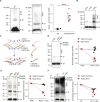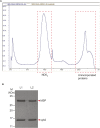Synaptobrevin2 monomers and dimers differentially engage to regulate the functional trans-SNARE assembly
- PMID: 38238088
- PMCID: PMC10796598
- DOI: 10.26508/lsa.202402568
Synaptobrevin2 monomers and dimers differentially engage to regulate the functional trans-SNARE assembly
Abstract
The precise cell-to-cell communication relies on SNARE-catalyzed membrane fusion. Among ∼70 copies of synaptobrevin2 (syb2) in synaptic vesicles, only ∼3 copies are sufficient to facilitate the fusion process at the presynaptic terminal. It is unclear what dictates the number of SNARE complexes that constitute the fusion pore assembly. The structure-function relation of these dynamic pores is also unknown. Here, we demonstrate that syb2 monomers and dimers differentially engage in regulating the trans-SNARE assembly during membrane fusion. The differential recruitment of two syb2 structures at the membrane fusion site has consequences in regulating individual nascent fusion pore properties. We have identified a few syb2 transmembrane domain residues that control monomer/dimer conversion. Overall, our study indicates that syb2 monomers and dimers are differentially recruited at the release sites for regulating membrane fusion events.
© 2024 Patil et al.
Conflict of interest statement
The authors declare that they have no conflict of interest.
Figures























Similar articles
-
Differential SNARE chaperoning by Munc13-1 and Munc18-1 dictates fusion pore fate at the release site.Nat Commun. 2024 May 16;15(1):4132. doi: 10.1038/s41467-024-46965-7. Nat Commun. 2024. PMID: 38755165 Free PMC article.
-
A structural role for the synaptobrevin 2 transmembrane domain in dense-core vesicle fusion pores.J Neurosci. 2015 Apr 8;35(14):5772-80. doi: 10.1523/JNEUROSCI.3983-14.2015. J Neurosci. 2015. PMID: 25855187 Free PMC article.
-
Distinct Functions of Syntaxin-1 in Neuronal Maintenance, Synaptic Vesicle Docking, and Fusion in Mouse Neurons.J Neurosci. 2016 Jul 27;36(30):7911-24. doi: 10.1523/JNEUROSCI.1314-16.2016. J Neurosci. 2016. PMID: 27466336 Free PMC article.
-
Synaptophysin-dependent synaptobrevin-2 trafficking at the presynapse-Mechanism and function.J Neurochem. 2021 Oct;159(1):78-89. doi: 10.1111/jnc.15499. Epub 2021 Sep 9. J Neurochem. 2021. PMID: 34468992 Review.
-
Energetics, kinetics, and pathways of SNARE assembly in membrane fusion.Crit Rev Biochem Mol Biol. 2022 Aug;57(4):443-460. doi: 10.1080/10409238.2022.2121804. Epub 2022 Sep 24. Crit Rev Biochem Mol Biol. 2022. PMID: 36151854 Free PMC article. Review.
References
Publication types
MeSH terms
Substances
LinkOut - more resources
Full Text Sources
